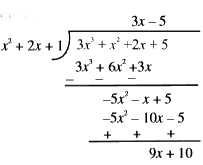Write the classification of connective tissue and their functions.Solution in Tamil
Video Solution
Text Solution
Connective tissues are classified into
I. Loose connective tissue
II. Dense connective tissue
III. Specialized connective tissue

I. Loose connective tissues: The cells and fibres are loosely arranged in a semi fluid ground substance. They are classified as
1. Areolar connective tissue:
It lies beneath the skin
Functions :
Acts as a support for epithelium. Acts as reservoir of water and salts for the surrounding body tissues. Hence it is called tissue fluid.
Adipose Tissue :
2. Found below the skin. 90% of the tissue contains Adipocytes or fat cells.
Functions:
Richly vascularised and supplies energy to the body while fasting.
(i) White fat : (White adipose tissue) Found in subcutaneous tissue surrounding kidneys, eye ball etc.
Functions: Store nutrients.
(ii) Brown fat : (Brown adipose tissue) contains abundant mitochondria.
Functions: Used to heat the blood stream to warm the body.
Reticular connective tissue : Matrix is filled with fibroblasts called reticular cells.
Function:
Forms an internal framework that supports the blood cells in the lymph nodes, spleen and bone marrow.

II. Dense connective tissues :
Fibres and fibroblasts are compactly packed based on orientation of fibres it is divided into:
1. Dense regular connective tissues : Primarily collagen fibres are arranged in rows between parallel bundles of tissues and few elastic fibres.
Fibroblast is the major cell type.
Functions:
Present in tendons that attach skeletal muscles to bones and ligaments.
Bones are attached to one another by ligaments. The tissue withstands tensile strength when pulling force is applied in one direction.
2. Dense irregular connective tissues : Have bundles of thick collagen fibres and fibroblasts arranged irregularly. Fibroblast is the major cell type.
Functions: The tissue can withstand tension exerted in many directions. Some elastic fibres are also present.
3. Elastic connective tissue: It contains high proportion of elastic fibres and allows recoil of tissues following stretching. Eg: Walls of arteries.
III. Specialised connective tissues : Classified as cartilage, bones and blood.
1. Cartilage:
Intercellular material is solid and pliable and resists compression. Cells of this tissue matrix secreted by them. Eg: Cartilage in ear pinna, Tip of nose etc.
2. Bones:
Hard and non pliable ground substance rich in calcium salts and collagen fibres which gives strength. cells or osteocytes are present in spaces called lacunae.
Functions:
Bones support and protect softer tissues and organs. Bone marrrow is site of production of blood cells.
3. Blood :
Fluid connective tissue containing plasma, RBC, WBC and platelets.
Functions:
Transport medium for the cardiovascular system carrying nutrients, wastes, respiratory gases throughout the body
|
Similar Questions
Write the structure and function of following connective tissues:
Blood
View SolutionWrite the structure and function of following connective tissues:
Lymph
View SolutionWrite the structure and function of following connective tissues:
Areolar tissue
View SolutionWrite the structure and function of following connective tissues: Adipose tissue
View SolutionWrite the structure and function of following connective tissues: Cartilage
View SolutionWrite the structure and function of following connective tissues: Bones
View SolutionWhat is connective tissue ? What are the types of connective tissues ? Write their functions.
View SolutionCell Junctions|Connective Tissue|Composition Of Connective Tissue|Cells|Fibres|Classification Of Connective Tissue|Connective Tissue Proper|Specialized Connective Tissue|OMR
View Solution

